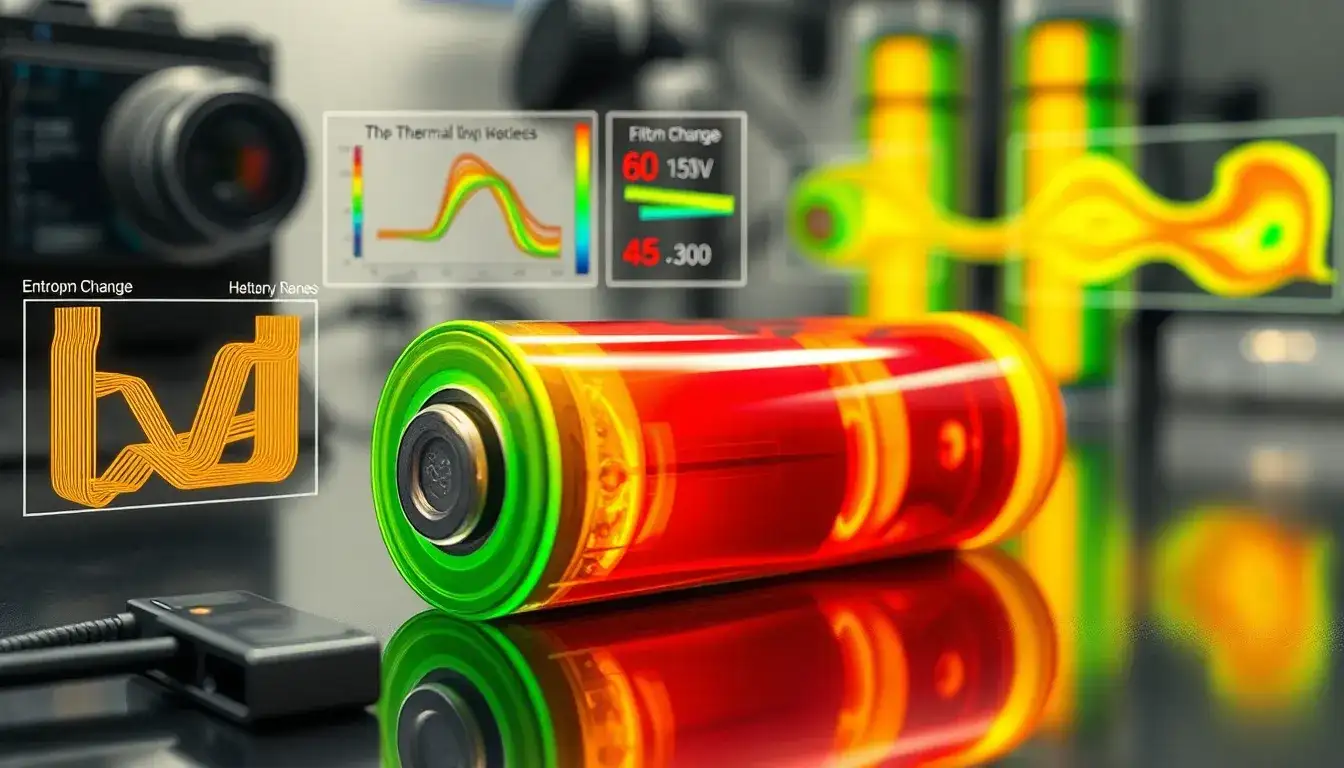
“`markdown
Evaluating the Role of Entropy Change in Lithium-Ion Battery Electro-Thermal Modelling
Abstract
Accurate estimation of the internal temperature of lithium-ion cells is essential for the safe operation of battery packs, especially during periods of high discharge rates. Operating outside the safe temperature range can lead to accelerated degradation or catastrophic failures. Heat generation in lithium-ion cells primarily comes from ohmic losses and entropy change (ΔS), the latter of which is often overlooked in battery modelling. This research emphasizes the importance of ΔS in enhancing the accuracy of electro-thermal models, particularly in high-fidelity thermal simulations. It systematically integrates ΔS into electro-thermal models using the energetic macroscopic representation (EMR) approach, a methodology not previously structured in this way. This paper presents a comparative analysis of an electro-thermal model (ETM) with and without ΔS, revealing that while entropy change minimally impacts electrical behavior prediction, it is crucial for accurately capturing temperature dynamics. The inclusion of ΔS can enhance temperature prediction accuracy by up to 4 °C, making it vital for applications requiring precise thermal management. This study provides detailed insights into when ΔS should be considered in simulations, offering practical guidance for battery engineers and researchers.
Keywords
lithium-ion battery; heat generation; entropic coefficient; electro-thermal model; electric equivalent circuit
1. Introduction
Lithium-ion batteries (LIBs) are widely utilized in various applications, from electric vehicles (EVs) to battery energy storage systems (BESS), where safety, durability, and reliability are critical. Temperature significantly influences the performance and longevity of LIBs, affecting key parameters such as cell impedance, capacity retention, and allowable charge/discharge rates. Additionally, temperature accelerates the degradation of electrode materials, a process known as aging. Recent incidents have highlighted the severe consequences of thermal runaway (TRA), which poses significant safety risks.
To ensure the safe and reliable operation of LIBs, it is crucial to maintain temperature and voltage within designated safe operational ranges. The battery management system (BMS) must accurately assess temperature dynamics and heat generation across various operating conditions to prevent accelerated degradation or TRA. Accurate thermal estimation is particularly vital during the battery pack design phase, influencing both thermal management strategies and overall system design.
Unlike other electrical components, LIBs are non-linear electrochemical systems where heat generation cannot be directly inferred from the nominal internal resistance value. Their behavior is influenced by a complex interplay of temperature, state of charge (SOC), and aging. Structural changes caused by lithium ion intercalation and de-intercalation during charge and discharge cycles lead to changes in entropy and enthalpy, affecting thermal and electrical properties.
Entropy (S) and entropy change (ΔS) are related concepts in the context of lithium-ion batteries but represent different aspects of thermodynamics within the system. Entropy quantifies the degree of disorder in the battery’s components and phases, while entropy change measures the difference in entropy between two states during chemical reactions or physical processes, such as charging and discharging. Understanding these entropy changes is vital for designing systems that manage temperature and prevent overheating.
Due to the lengthy and complex process of characterizing ΔS, it is often overlooked in system-level models, such as those used for electric vehicle simulations. This omission can result in discrepancies between measurements and model predictions. This paper investigates whether accounting for entropy change can enhance the accuracy of heat generation and temperature estimations in lightweight electro-thermal models used in BMS and system-level performance assessments.
2. Methodology
A rigorous methodology was employed to assess the impact of entropy change. A comprehensive model was developed using MatLab/Simulink, providing a framework for analysis. The model’s parameters, essential for accurate simulation, were determined through various experimental methods, including impedance and open-circuit voltage measurements, as well as the coefficient of convection and entropy change.
To validate the model’s fidelity and predictive capability, it was benchmarked against real-world data obtained from continuous discharge and actual driving cycles. The model’s accuracy was evaluated under constant current discharge and dynamic profile scenarios, providing insights into the significance of considering ΔS. Simulations were conducted to explore various scenarios of continuous currents and power discharge at different rates, guiding engineers on the inclusion of entropy change in simulations.
3. Results
The parameters of the electro-thermal model were measured through independent characterization procedures. The model validation was performed using the same setup with constant current discharge (1 C) and dynamic current conditions. Results showed that entropic heating significantly influenced temperature estimation, and neglecting it resulted in a temperature error exceeding 2 °C during discharge.
Further validation was conducted on a cell using a dynamic cycle representative of a light electric vehicle drive cycle. The voltage error of the model was less than 70 mV throughout most of the discharge, with a temperature error remaining under 1 °C. This indicates that entropy change plays a crucial role in accurately tracking temperature dynamics, although it has a negligible effect on electrical model accuracy.
4. Simulations
After validating the model, the impact of the entropic effect was explored in comparison with Joule losses. Simulations for constant current discharge across various C-rates indicated that while the entropic effect was minimal at low discharge rates, it could cause a maximum error of 4 °C at higher rates. For constant power discharge scenarios, the differences caused by considering entropic heat generation were less significant for temperature estimation and total heat generation.
5. Conclusions
As the use of lithium-ion batteries in power-intensive applications increases, estimating their thermal behavior through electro-thermal models becomes crucial for designing safer, longer-lasting, and more reliable battery packs. This research addresses the importance of ΔS in electro-thermal modelling, systematically incorporating entropy change to enhance predictive frameworks. The findings show that neglecting entropy can result in a temperature error of up to 4 °C, highlighting the necessity of its inclusion for precise thermal management in high-fidelity simulations. Future work should focus on automating entropy measurement processes and applying these insights to new battery chemistries or advanced thermal management systems.
“`
Original article by NenPower, If reposted, please credit the source: https://nenpower.com/blog/the-impact-of-entropy-change-on-electro-thermal-modelling-of-lithium-ion-batteries/


